Gea Casolaro
30.09.2019 – 20.12.2019
Exhibition Views

Molto visibile, troppo invisibile, 2019, installation view at The Gallery Apart (ground floor), photo by Giorgio Benni 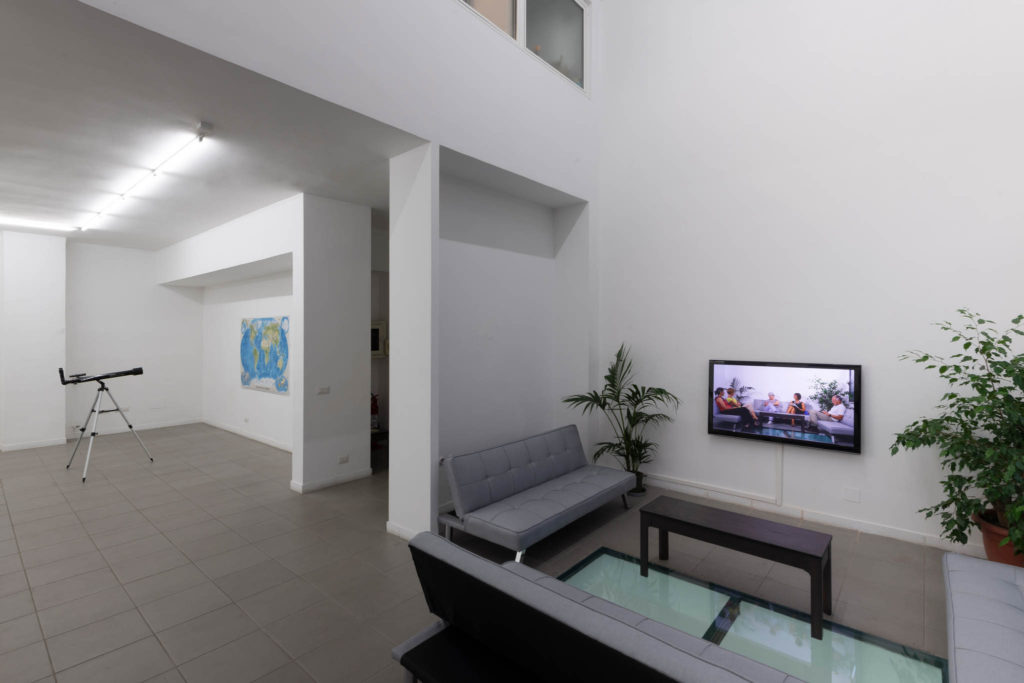
Molto visibile, troppo invisibile, 2019, installation view at The Gallery Apart (ground floor), photo by Giorgio Benni 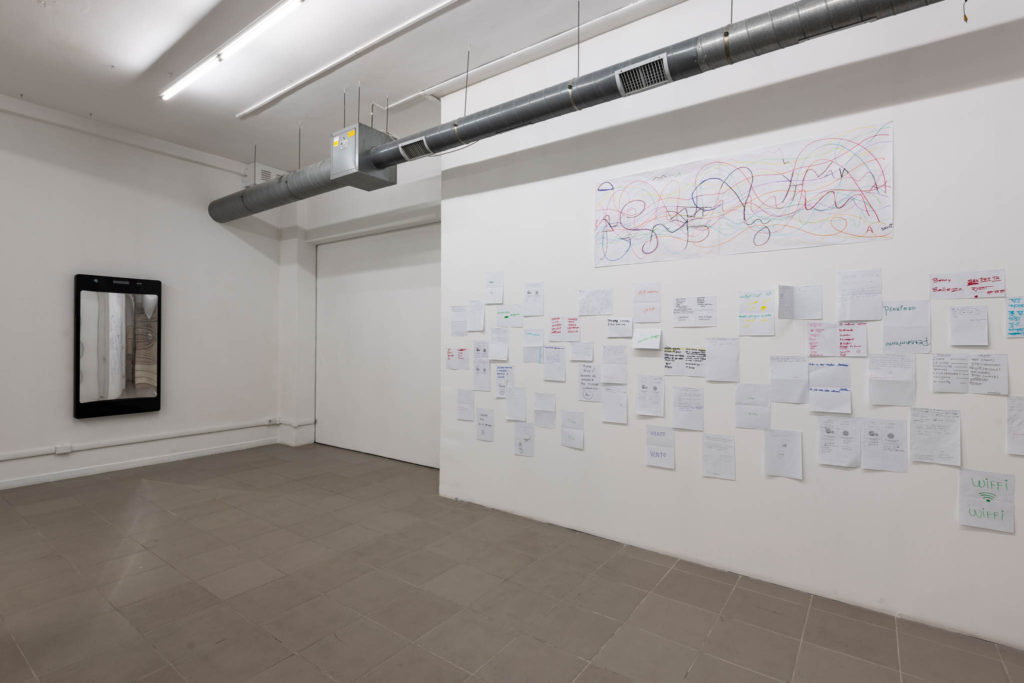
Molto visibile, troppo invisibile, 2019, installation view at The Gallery Apart (basement), photo by Giorgio Benni 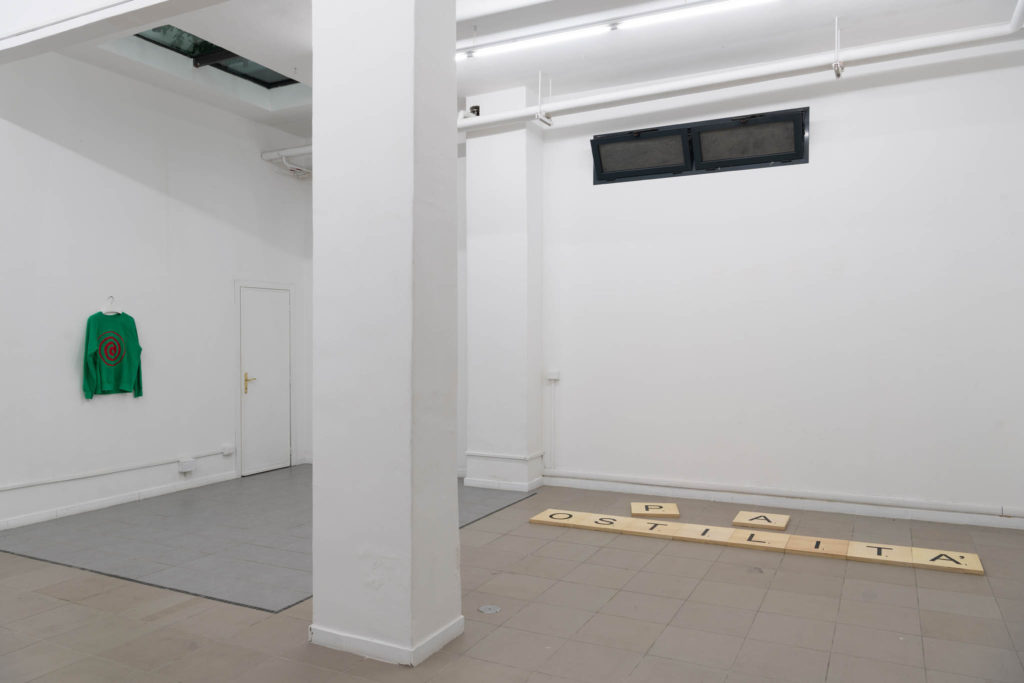
Molto visibile, troppo invisibile, 2019, installation view at The Gallery Apart (basement), photo by Giorgio Benni
Works

Il cielo stellato e la legge morale, 2019, world physical map, telescope, photo by Giorgio Benni 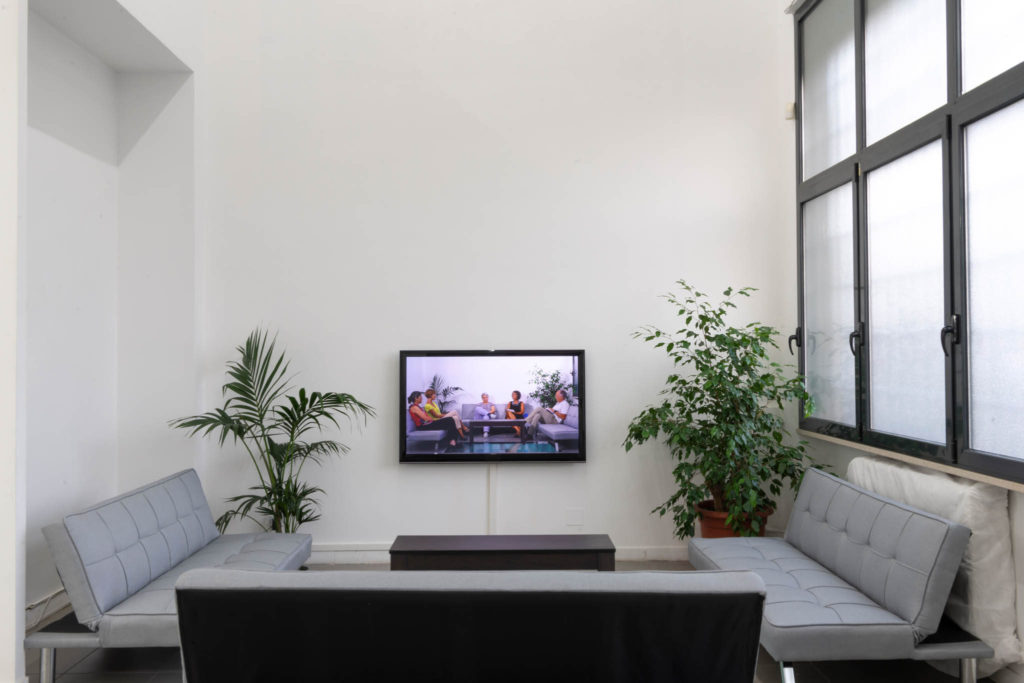
Molto visibile, troppo invisibile, 2019, video installation, color HD video, 00:54:00, three couches, two plants, TV monitor, photo by Giorgio Benni 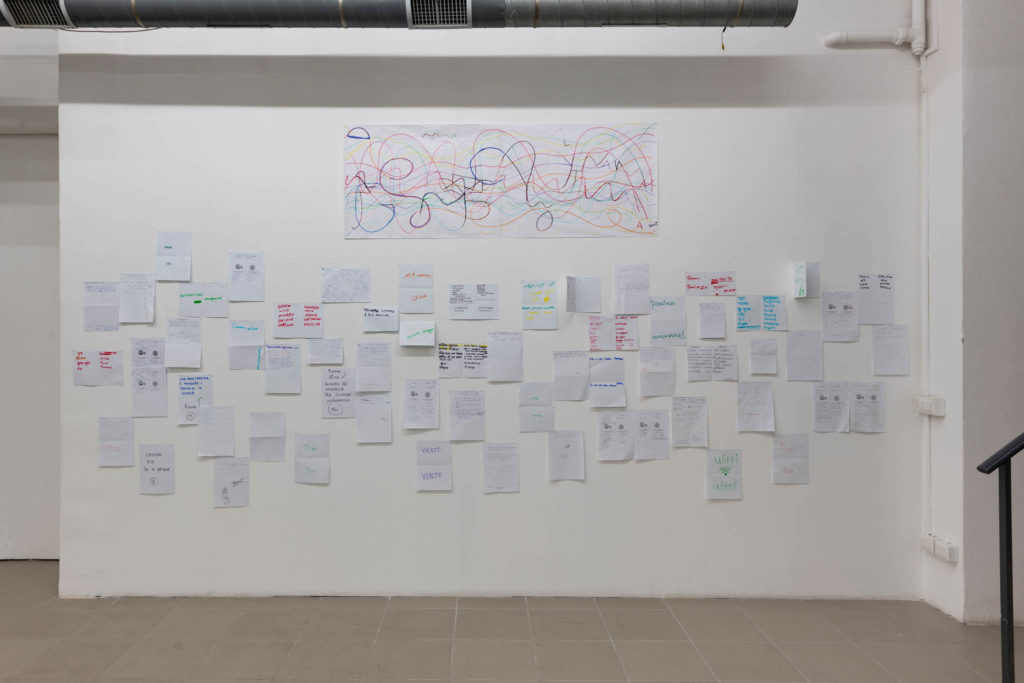
Cosa è invisibile?, 2019, texts and drawings on paper, selection of the works produced during the workshop realized by Gea Casolaro with the students of the Italian course for foreigners led by Lapo Vannini of the Matemù – Cies Association of Rome, photo by Giorgio Benni 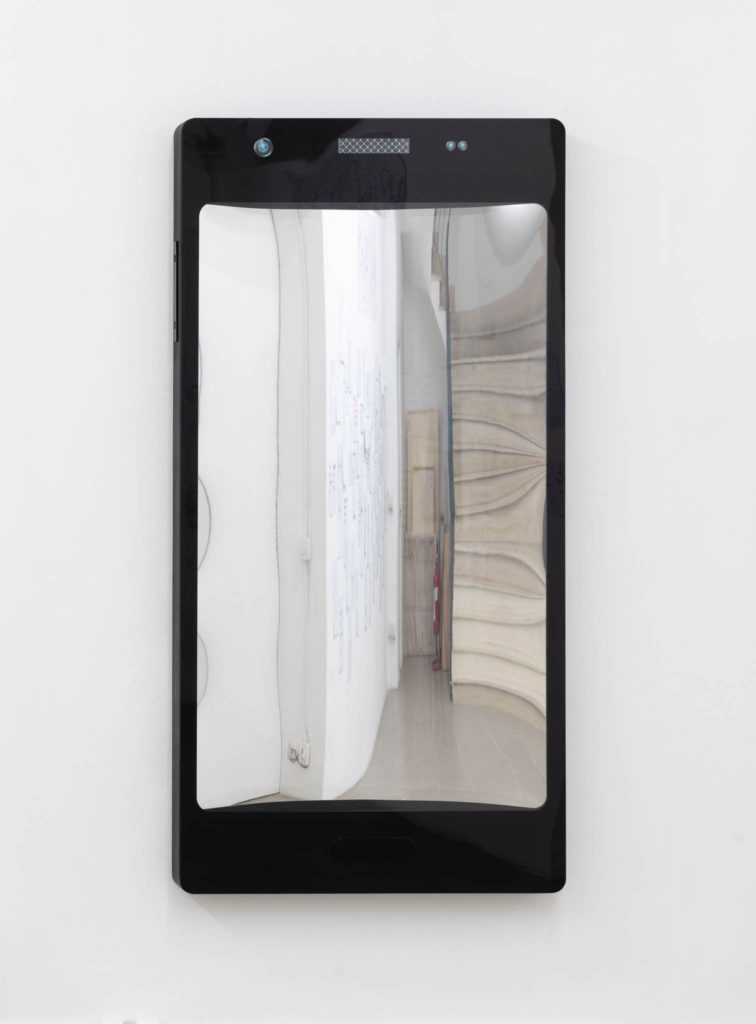
Specchio delle mie brame, 2019, wood and plexiglass, 160 x 80 x 8 cm, photo by Giorgio Benni 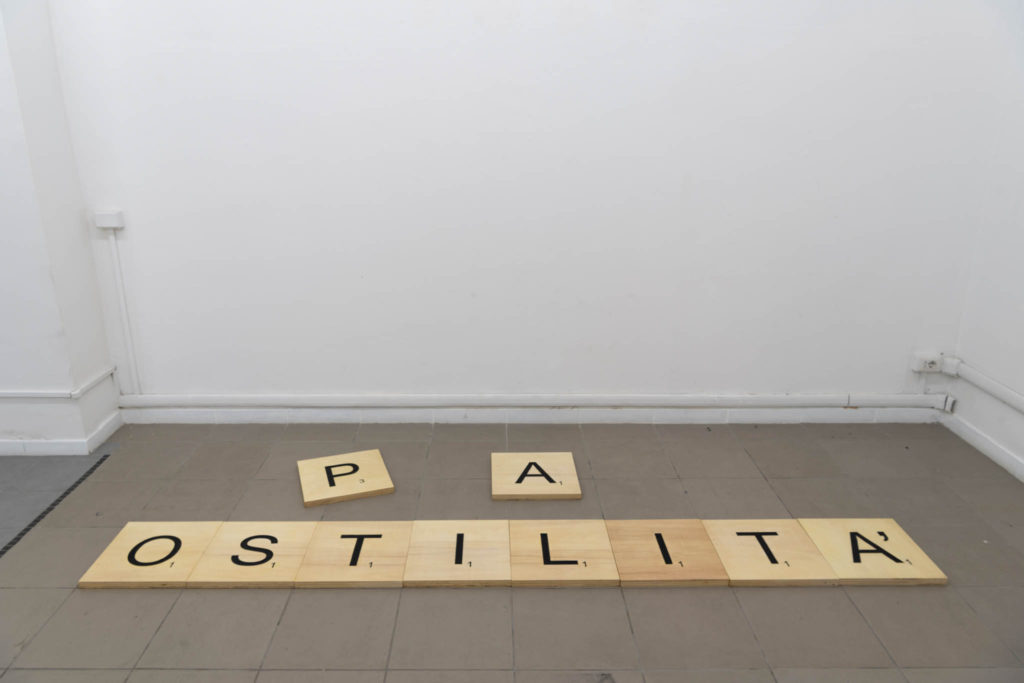
Chi utilizza più lettere vince, 2019, laser engraving on ten wooden tablets, 40 x 40 x 3 cm each, photo by Giorgio Benni 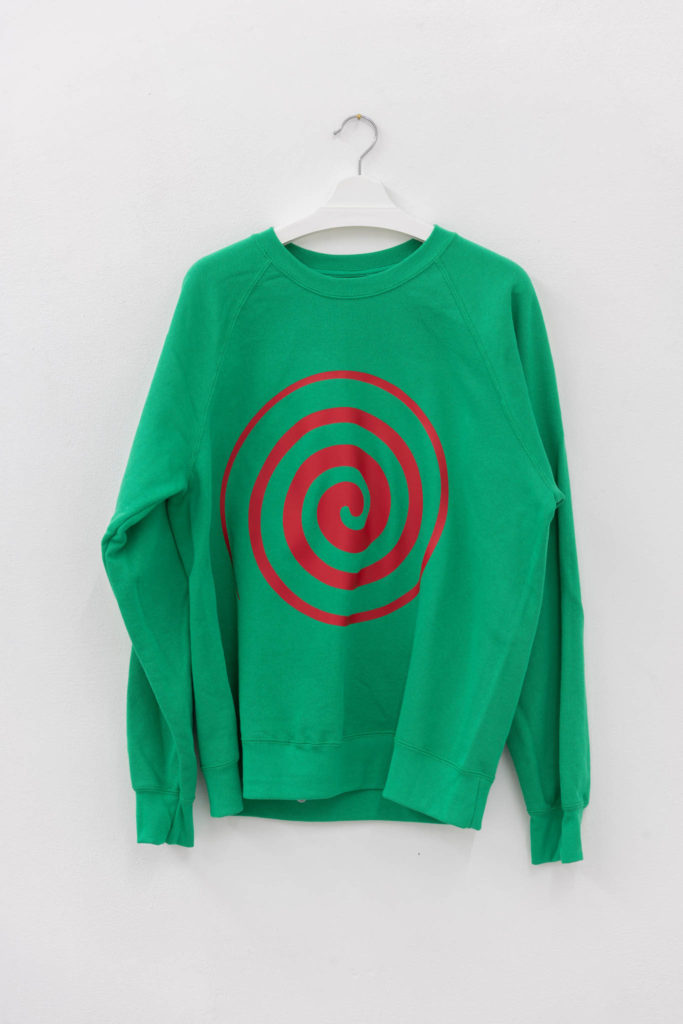
Per gli Ubu di oggi, 2019, print on sweatshirt, size XL, photo by Giorgio Benni 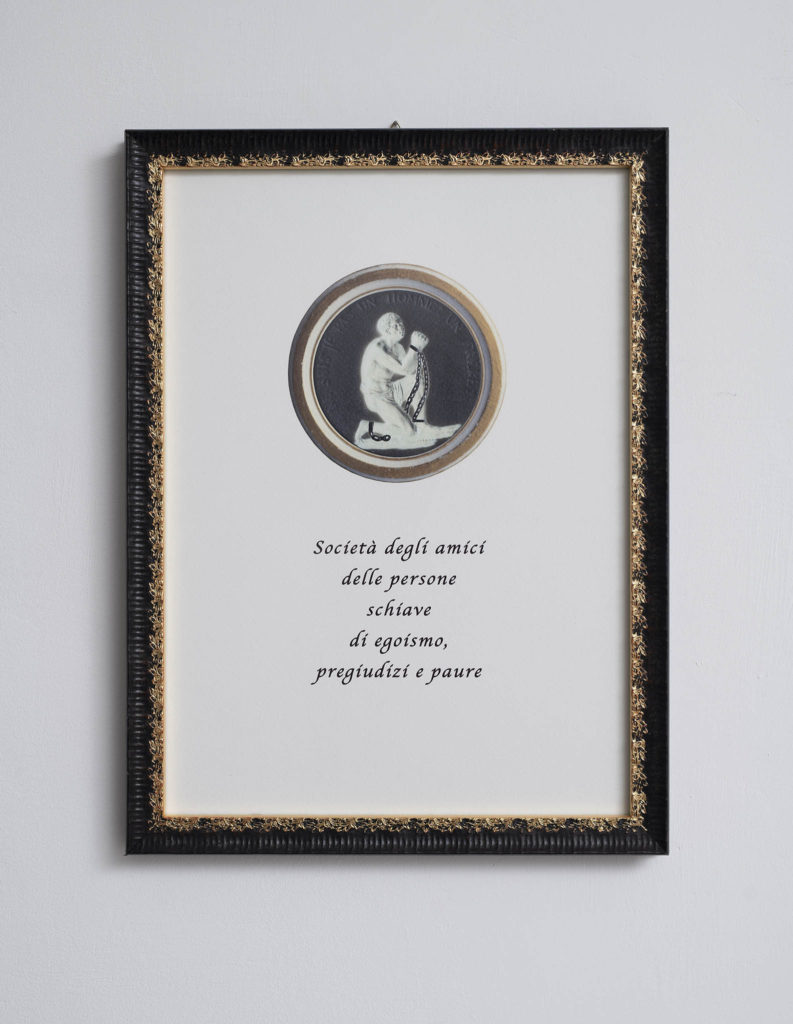
Il mondo a rovescio, 2019, print on hammered paper and frame, modified reproduction of the medallion of the Société des amis des Noirs (1788), 45 x 34 cm, photo by Giorgio Benni 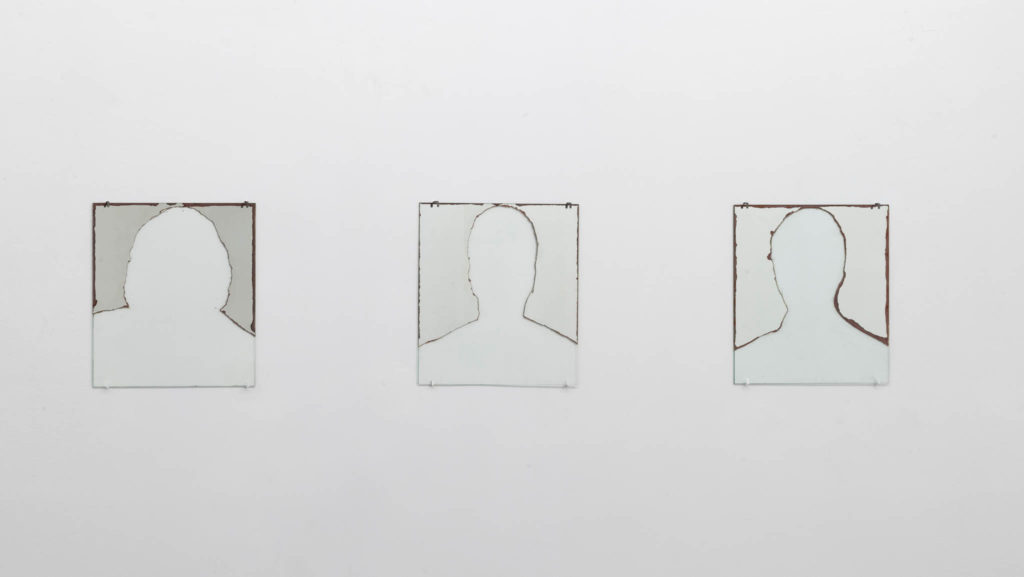
Mancanza di riflessione (titolo originale: Non siamo che immagini negli occhi degli altri), 1994, three partially abraded mirrors, 40 x 40 cm each, photo by Giorgio Benni 
L’assenza, 2019, print on t-shirt, size M, photo by Giorgio Benni
The Gallery Apart is proud to present MOLTO VISIBILE, TROPPO INVISIBILE (Very Visible, Too Invisible), the new project by Gea Casolaro through which the artist offers her contribution to the ethical and moral question about the fate of our planet as well as the individual and collective consciousness. The exceptionality of the current times, the uncertainty of the stability of the democratic institutions, the materialisation of a catastrophic environmental scenario, the tragic inability to prevent and manage the migration flows and the resulting nationalist and racist instincts lead Gea Casolaro to suggest interpretations that eschew an excessively abstract approach from the problems, an attitude which is itself origin and concause of the difficulty in finding solutions.
Such ambition to concreteness underlies the artistic practice of Casolaro. The investigation into the several ways of vision, on which the artists has based most of her poetics, is used to launch meaningful connections aimed at generating doubts and reflections in the viewer. An inclination towards multidimensionality already transpired from her past photography exhibitions, but the need to incorporate the plurality of views, as well as the urge to foster critical masses in order to challenge the contemporaneity, to Casolaro represent the reason for adopting new approaches in her artmaking practice. Hence, on one hand her predilection for processes of engagement and participation in creating her artworks and on the other hand her experimentation, as opposed to the compulsive use of the images of today’s communication.
The project MOLTO VISIBILE, TROPPO INVISIBILE is also the result of this creative approach. Along with the philosopher Enrico Castelli Gattinara, Casolaro has invited some renowned speakers to take part in the talks held in the gallery spaces with the aim of exploring topical issues from even eccentric, but never dull points of view. From these meetings the artist has drawn the material to create the video from which the exhibition takes its name. At the same time, she has worked with a group of young foreigners arrived in Italy, intentionally outside any classification (regular/irregular, asylum seeker, refugee, economic migrant), to underline the common belonging to one humanity whose members, nobody excluded, should be guaranteed the fundamental rights, including the right to dream of a better future. Her work shows how the desire of several migrants is first and foremost that of improving themselves. And the artist urges to reflect on how these ambitions and this energy may revitalize our exhausted societies.
As in all her works, Casolaro acts by elicitation, exploiting the powerful images that take shape and unfold in her mind and that she brings to the attention of who, through art, calls if not for solutions, at least for credible interpretations. The need for concreteness exhorts the artist to reify her goad-images in real tridimensional objects. Thus, sculpture pieces stand alongside the videos and the works of participatory art, which Casolaro manages to treat for what they are: pure images. The sweatshirt with the symbol from the costume of Ubu Roi to evoke the many, homebred and not, Ubus, whom the fate of the Nations and civil coexistence have to face. The telescope aimed at a physical planisphere significantly entitled Il cielo stellato e la legge morale (The starry sky and the moral law), inspired in a Kantian-like way by the need to reflect upon our own role on this planet that has to be protected and preserved in its entire and precious universality, without any boundary, distinction nor economic interests. And Specchio delle mie brame, powerful anti-monument to incommunicability and to a distorted view of reality which characterizes today’s communication. Finally Torno subito, an incitement to reclaim our role as sentient and rational women and men after a too long, and still ongoing, intellectual break: the ringing of an alarm clock, or of a bell, which Casolaro entrusts to a message on a T-shirt significantly left white.
MAXXI, the National Museum of 21st Century Arts, in Rome will host a show featuring the video works by Gea Casolaro titled “La poesia dell’impegno” from 9 to 13 October in the Video Gallery – powered by IN BETWEEN ART FILM. The exhibit will be introduced by a talk with the artist. Admission is free subject to availability. For further information visit www.maxxi.art.
GEA CASOLARO Born in Rome (I) in 1965. She leaves and works between Rome (I) and Paris (F)
Her twenty-year long work explores the relationship with the images, the contemporaneity, the society, and history, through photography, video and writing. Her research aims at triggering an ongoing and permanent dialogue between the experiences and people, in order to expand the analytical skills to examine reality through different points of view. With an approach that evokes the practices of sociologists and philosophers, urban landscapes and their dwellers catch our attention: Human landscapes is the title of a series created between Berlin, Rome, Buenos Aires and Shanghai since 1997, whereas Visioni dell’EUR (2002-2006) portrays landscapes from neighbourhoods, synonym for modernity in the Sixties and therefore chosen by the greatest Italian film director as a “supporting actor” of their films. She won the Suzzara Prize in 1996. In 1988, she took part in the talks of the Biennial of Young Artists from Europe and the Mediterranean which took place in Sarajevo. In 2003 her video-installation, created in Buenos Aires (Doppio sguardo, 2003), featured in the XIV AnteprimaQuadriennale in Naples; in 2008, a video-installation to commemorate those who have died in workplace incidents (Ai caduti di oggi, 2008), was showcased during the XV Quadriennale at the Palazzo delle Esposizioni in Rome. Among her most important projects are: Maybe in Sarajevo in 1998, a poetic tribute to the city as a crossroads of cultures and religions, devastated by years of war; the video Volver atrás para ir adelante shot in Buenos Aires in 2003, during the economic crisis, featuring scenes of street life, protests, demonstrations, distracted passers-by, facing the dreadful events of the dictatorships in the Seventies. The video was presented in several venues and exhibitions, such as the Teatro India in Rome, the Festival International de Cinéma Vision du réel di Nyon in Switzerland, the Raid Project in Los Angeles, and in 2007 at the One World Berlin Filmfestival. The work Permanente presenza, commissioned in 2007 by the Mart, was showcased in a solo exhibition at the Contemporary Art Museum in Trento and Rovereto (Italy); 2010 was the year she created the image of the CGIL trade union membership card on occasion of the 40th anniversary of the approval of the Workers’ Charter, and the solo show South at the The Gallery Apart in Rome featuring two works on the perception of the landscape produced in New Zealand and France, respectively. In 2009 she spent nine months on an artist-in-residence programme at the Cité Internationale des Arts in Paris (France) to work on her project Still here focused on the relationship between cinema and everyday life in the French capital. In 2011, she exhibited in the Italian Pavilion during the 54th Art Biennale of Venice, at the Italian Cultural Institute in Strasbourg (France), and in 2012 at the Festival Images in Vevey (Switzerland). The project Sharing Gaze dates back to 2013. It is the product in two chapters of the workshop carried out with a group of students in their final years of the Fine Arts Academy in Addis Abeba during her artist-in-residence at the local Italian Cultural Institute, and Mille e una di queste notti, first public screening of the video, for the fourth anniversary of the earthquake at the MU.SP.A.C. Museo Sperimentale d’Arte Contemporanea in L’Aquila (Italy). Still in 2013 she realized two commissioned photo exhibitions: the first in the Principality of Monaco (the work Forever Monte-Carlo was exhibited at The Forbes Galleries in New York); the second in Luxembourg at the CNA Centre nationale de l’audiovisuel, where she carried out a portrait of the complex multi-faces of the Country through a relational mail-art exhibit, titled Send Me a Postcard, a site aside, inside, in between, away. In 2015 she participated in a residency programme for more than two months at the Italian Cultural Institute in Lima for a participatory art project inspired by the work of the Andean photographer Martín Chambi, with the participation of a group of students of the Centro de la Imagen. In 2016, she won the competition of the Comune di Casale Monferrato (Italy) for the creation of a public art monument for the Parco Eternot on the same site where once the notoriously famous Eternit factory was built, whereas in 2019 she created the permanent art installation Arbor vitae – Giù le armi dalle mani at the Mufar – Museo Fabbrica d’Armi delle Reali Ferriere di Mongiana. The sweeping retrospective exhibition Con lo sguardo dell’altro was inaugurated in 2017 at the Macro Museum in Rome, curated by Claudio Crescentini, it was hosted in two halls of the museum and in the video rooms and also extended to an display of its most significant catalogues and books in the museum library. Between 2017 and 2018 Casolaro created two important participatory art projects, both in Rome, involving groups of people who from time to time took part in the creative process: Il legame con la storia libera l’immaginazione, with the students of the Liceo Classico E. Q. Visconti, and Nel corpo della città, a multi-site exhibition which unfolded between the Museo Laboratorio della Mente, the Archivio Storico Capitolino and the Biblioteca Nazionale Sportiva of CONI. Featured in the prestigious Donata Pizzi Collections, her works have been showcased at the International Exhibition of Triennale Milano, at the Palazzo delle Esposizioni in Rome, and at the Museo di Santa Giulia in Brescia, all venues that have hosted the Collection. Selected in 2017 by the artists presented in Corea at Casa Italia on the occasion of the Winter Olympic Games, in 2019 the Italian Cultural Institute in Lisbon dedicate her the solo exhibit “Riflessioni”, whereas Gaia Bindi and Piero Gilardi have invited to participate in the exhibit “RESILIENZA/RESISTENZA” at PAV – Parco Arte Vivente in Turin (Italy).
Works by Casolaro are exhibited in important public and private art collections, such as: MAXXI Museo Nazionale delle Arti del XXI secolo, Rome; CNA – Centre National de l’Audiovisuel, Dudelange, Luxembourg; Mart – Museo d’Arte Contemporanea in Trento and Rovereto; MU.SP.A.C. Museo Sperimentale d’Arte Contemporanea in L’Aquila; Collezione Farnesina Experimenta, Ministry for Foreign Affairs, Rome; Collezione della Fondazione Quadriennale in Rome; Collezione CGIL Confederazione Generale Italiana del Lavoro, Rome; Pinacoteca Comunale in Terni; Collezione Provincia Autonoma di Bolzano; Collezione storica del Premio Suzzara; Monumento Parco Eternot Comune di Casale Monferrato; Museo Laboratorio della mente, Rome; Mufar, Museo delle armi delle Reali Ferriere Borboniche, Mongiana.
The Gallery Apart è orgogliosa di presentare MOLTO VISIBILE, TROPPO INVISIBILE, il nuovo progetto con cui Gea Casolaro offre il suo contributo a quell’interrogativo etico e morale che riguarda il destino del pianeta non meno che la coscienza individuale e collettiva. L’eccezionalità dei tempi correnti, l’incertezza sulla tenuta delle istituzioni democratiche, il concretizzarsi di uno scenario ambientale catastrofico, la tragica incapacità di prevenire e gestire i flussi migratori e le conseguenti pulsioni nazionaliste e razziste portano Gea Casolaro a proporre chiavi di lettura che rifuggano da un approccio troppo astratto ai problemi, atteggiamento di per sé origine e concausa della difficoltà nella ricerca di soluzioni.
Tale aspirazione alla concretezza è alla base della pratica artistica di Casolaro. L’indagine sulle molteplici modalità di visione, a cui l’artista ha improntato gran parte della sua poetica, viene utilizzata per lanciare connessioni di senso atte a generare dubbi e riflessioni nello spettatore. Già nei suoi lavori fotografici del passato è palese una tensione verso la multidimensionalità, ma l’esigenza di inglobare la pluralità dei punti di vista, oltre che una sollecitazione alla formazione di massa critica per sfidare la contemporaneità, costituisce per Casolaro motivo per adottare nuove modalità operative nella sua pratica artistica. Da qui la predilezione per processi di coinvolgimento e compartecipazione nella realizzazione delle sue opere e la sperimentazione, negli anni, di nuove forme di espressione, in contrapposizione all’uso compulsivo delle immagini della comunicazione di oggi.
Anche MOLTO VISIBILE, TROPPO INVISIBILE è frutto di questo approccio creativo. Insieme al filosofo Enrico Castelli Gattinara, Casolaro ha invitato alcune personalità a partecipare a degli incontri svoltisi all’interno degli spazi della galleria con lo scopo di sviscerare, da punti di vista anche eccentrici e mai banali, tematiche di attualità. Da questi incontri l’artista ha tratto il materiale per realizzare il video che dà il titolo alla mostra. Parallelamente ha lavorato con un gruppo di giovani stranieri appena giunti in Italia, volutamente al di fuori di ogni categorizzazione (regolare/irregolare, rifugiato, profugo, migrante economico) a sottolineare la comune appartenenza ad un’unica umanità ai cui membri, nessuno escluso, andrebbero garantiti i diritti fondamentali, compreso quello al sogno di un futuro migliore. Dal lavoro di Casolaro emerge come il desiderio di moltissimi migranti sia anzitutto quello di migliorare se stessi. E l’artista spinge a riflettere su quanto queste aspirazioni e questa energia potrebbero essere un carburante rigenerativo per le nostre stanche società.
Casolaro come sempre agisce per sollecitazione, sfruttando la forza delle immagini che si formano nella sua mente e che restituisce all’attenzione di chi, attraverso l’arte, chiede se non soluzioni, quanto meno credibili interpretazioni. L’esigenza di concretezza spinge l’artista a reificare le sue immagini-pungolo in veri oggetti tridimensionali. Ecco dunque che al video e ai lavori di arte partecipata si aggiungono oggetti-scultura che Casolaro riesce a trattare per quello che sono: pure immagini. La felpa con il simbolo tratto dal costume di Ubu Roi ad evocare i tanti Ubu, nostrani e no, con cui il destino delle Nazioni e l’intera convivenza civile devono fare i conti. Il telescopio puntato su un planisfero fisico dal significativo titolo Il cielo stellato e la legge morale, kantianamente ispirato all’esigenza di riflettere sul proprio ruolo su questo pianeta da preservare nella sua preziosa ed integrale universalità, senza distinzioni di confini o di interessi economici. Ed ancora Specchio delle mie brame, efficace antimonumento all’incomunicabilità e a una distorta visione della realtà che contraddistingue le comunicazioni di oggi. E infine Torno subito, un incitamento a riprendere il nostro ruolo di donne e uomini senzienti e raziocinanti dopo un periodo troppo lungo, e ancora in corso, di ricreazione intellettuale: il suono di una sveglia, o se si vuole di una campanella, che Casolaro affida ad un messaggio su una maglietta significativamente vuota.
Il MAXXI – Museo Nazionale delle arti del XXI secolo di Roma dedicherà all’opera video di Gea Casolaro un focus dal titolo “La poesia dell’impegno” che si terrà dal 9 al 13 ottobre nella Video Gallery – powered by IN BETWEEN ART FILM. La rassegna sarà introdotta da un talk con l’artista con ingresso libero fino ad esaurimento posti. Per ulteriori informazioni www.maxxi.art.
GEA CASOLARO Nata a Roma (I) nel 1965. Vive e lavora tra Roma (I) e Parigi (F)
Il suo lavoro ventennale indaga, attraverso la fotografia, il video e la scrittura, il rapporto con le immagini, l’attualità, la società, la storia. La sua ricerca mira ad attivare un dialogo permanente tra le esperienze e le persone, per ampliare la capacità di analisi e di conoscenza della realtà attraverso i punti di vista altrui. Con un approccio vicino alle pratiche di sociologi e filosofi, il suo sguardo si posa sui paesaggi urbani e le persone che li vivono: Human landscapes è il titolo di una serie realizzata tra Berlino, Roma, Buenos Aires e Shanghai a partire dal 1997, mentre Visioni dell’EUR (2002-2006) si concentra sui paesaggi del quartiere, sinonimo di modernità negli anni ’60 e per questo scelto dai più grandi registi italiani come “co-protagonista” dei loro film.
Vince il Premio Suzzara nel 1996, partecipa nel 1998 agli incontri della Biennale dei Giovani Artisti dell’Europa e del Mediterraneo a Sarajevo. È presente nel 2003 alla XIV Anteprima-Quadriennale di Napoli con una video-installazione realizzata a Buenos Aires (Doppio sguardo, 2003) e nel 2008 alla XV Quadriennale al Palazzo delle Esposizioni di Roma con una video-installazione in ricordo dei morti sul lavoro (Ai caduti di oggi, 2008).
Tra i suoi progetti più famosi ricordiamo: Maybe in Sarajevo del 1998, un omaggio poetico alla città incrocio di culture e religioni differenti, devastata da anni di guerra; il video Volver atrás para ir adelante girato a Buenos Aires nel 2003, durante la crisi economica, con riprese della vita di strada tra proteste, manifestazioni e passanti distratti, messi a confronto con i terribili eventi della dittatura degli anni ‘70. Il video è stato presentato in diversi spazi e rassegne tra cui il Teatro India di Roma, il Festival International de Cinéma Vision du réel di Nyon in Svizzera, il Raid Project di Los Angeles e nel 2007 il One World Berlin Filmfestival.
È del 2007 il progetto Permanente presenza commissionato dal Mart ed esposto in una mostra personale nel Museo di arte contemporanea di Trento e Rovereto; del 2010 la realizzazione dell’immagine della tessera della CGIL in occasione del quarantennale dell’approvazione dello Statuto dei Lavoratori e la personale South presso The Gallery Apart di Roma con due lavori sulla percezione del paesaggio realizzati rispettivamente in Nuova Zelanda e in Francia. Nel 2009 è in residenza per nove mesi presso la Cité Internationale des Arts di Parigi per lavorare al suo progetto Still here sul rapporto tra cinema e vita quotidiana nella capitale francese. Nel 2011 partecipa al Padiglione Italia nel mondo in occasione della 54a Biennale di Venezia, presso l’Istituto Italiano di Cultura di Strasburgo in Francia e nel 2012 al Festival Images di Vevey in Svizzera.
Del 2013 sono Sharing Gazes, risultato in due capitoli del workshop, realizzato con gli studenti dell’ultimo anno dell’Accademia di Belle Arti e Design di Addis Abeba nel corso di una residenza dell’artista presso il locale Istituto Italiano di Cultura, e Mille e una di queste notti, prima proiezione pubblica del video, in occasione del quarto anniversario del terremoto al MU.SP.A.C. Museo Sperimentale d’Arte Contemporanea di L’Aquila. Sempre nel 2013 ha realizzato due missioni fotografiche commissionate: la prima nel Principato di Monaco (il lavoro Forever Monte-Carlo è stato esposto presso The Forbes Galleries a New York); la seconda in Lussemburgo al CNA Centre nationale de l’audiovisuel, dove ha realizzato un ritratto delle complesse sfaccettature del Paese attraverso una mostra di mail-art-relazionale, intitolata Send Me a Postcard, a site aside, inside, in between, away.
Nel 2015 è stata in residenza per oltre due mesi presso l’Istituto Italiano di Cultura di Lima per un progetto di arte partecipativa ispirato al lavoro del fotografo andino Martín Chambi, con un gruppo di studenti del Centro de la Imagen. Nel 2016 ha vinto di concorso del Comune di Casale Monferrato per la realizzazione di un monumento di arte pubblica per il Parco Eternot nato sul sito dove sorgeva la tristemente famosa fabbrica Eternit, mentre nel 2019 ha realizzato l’installazione permanente Arbor vitae – Giù le armi dalle mani al Mufar – Museo Fabbrica d’Armi delle Reali Ferriere di Mongiana nell’ambito del progetto Ceilings curato da Simona Caramia.
È del 2017 la mostra antologica Con lo sguardo dell’altro al Macro di Roma, un’ampia panoramica, curata da Claudio Crescentini, dislocata su due sale del museo ed estesa anche alle salette video e ad una rassegna dei suoi più significativi cataloghi e libri d’artista esposti in biblioteca. Fra il 2017 e il 2018 Casolaro ha realizzato, entrambi nella città di Roma, due importanti e vasti progetti di arte partecipativa, coinvolgendo di volta in volta gruppi di persone che da protagonisti sono entrati nel processo creativo: Il legame con la storia libera l’immaginazione, con gli studenti del Liceo Classico E. Q. Visconti, e Nel corpo della città, mostra diffusa sviluppatasi tra il Museo Laboratorio della Mente, l’Archivio Storico Capitolino e la Biblioteca Nazionale Sportiva del CONI.
Presente nella prestigiosa Collezione Donata Pizzi, sue opere sono state esposte alla Triennale di Milano, al Palazzo delle Esposizioni di Roma e al Museo di Santa Giulia a Brescia, tutte sedi che hanno accolto la Collezione. Scelta tra gli artisti presentati in Corea a Casa Italia in occasione delle Olimpiadi invernali del 2107, nel 2019 l’Istituto Italiano di Cultura di Lisbona le ha dedicato la personale “Riflessioni” mentre Gaia Bindi e Piero Gilardi l’hanno invitata a partecipare alla mostra “RESILIENZA/RESISTENZA” in corso al PAV – Parco Arte Vivente di Torino. A partire dal prossimo 9 ottobre, il MAXXI di Roma dedicherà a Gea Casolaro un focus sulla sua produzione video.
Opere di Casolaro sono presenti in importanti collezioni pubbliche e private tra cui: MAXXI Museo Nazionale delle Arti del XXI secolo, Roma; CNA – Centre National de l’Audiovisuel, Dudelange, Luxembourg; Mart – Museo d’Arte Contemporanea di Trento e Rovereto; MU.SP.A.C. Museo Sperimentale d’Arte Contemporanea de L’Aquila; Collezione Farnesina Experimenta, Ministero degli Affari Esteri, Roma; Collezione della Fondazione Quadriennale di Roma; Collezione CGIL Confederazione Generale Italiana del Lavoro, Roma; Pinacoteca Comunale di Terni; Collezione Provincia Autonoma di Bolzano; Collezione storica del Premio Suzzara; Monumento Parco Eternot Comune di Casale Monferrato; Museo Laboratorio della mente, Roma; Mufar, Museo delle armi delle Reali Ferriere Borboniche, Mongiana.
share on